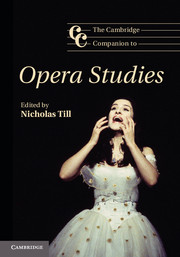Book contents
- Frontmatter
- Contents
- Contributors
- Acknowledgements
- Introduction: opera studies today
- Part One Institutions
- Part Two Constituents
- Part Three Forms
- 8 The dramaturgy of opera
- 9 Genre and poetics
- 10 The operatic work: texts, performances, receptions and repertories
- Part Four Issues
- Further reading
- Index
- References
10 - The operatic work: texts, performances, receptions and repertories
from Part Three - Forms
Published online by Cambridge University Press: 05 December 2012
- Frontmatter
- Contents
- Contributors
- Acknowledgements
- Introduction: opera studies today
- Part One Institutions
- Part Two Constituents
- Part Three Forms
- 8 The dramaturgy of opera
- 9 Genre and poetics
- 10 The operatic work: texts, performances, receptions and repertories
- Part Four Issues
- Further reading
- Index
- References
Summary
In 1998 the American soprano Renée Fleming fell foul of what one journalist has called ‘the style police’ at La Scala in Milan. Performing the title role in Donizetti’s Lucrezia Borgia, Fleming encountered opposition from the conductor Gianluigi Gelmetti when she introduced some decorative appoggiaturas into her vocal lines. As Philip Gossett puts it in his account of the event, Gelmetti has ‘an exaggerated respect for notation’. Since composers like Donizetti normally left appoggiaturas to the intelligence of performers they did not write them into their scores, and Gelmetti had taken this as authority for refusing Fleming’s additions. The tensions that occurred in preparation for the performances led to a classic La Scala brouhaha on the opening night in which, in Gossett’s words, ‘general havoc reigned and Gelmetti collapsed’.
The incident was caused by two contradictory understandings of the nature of the operatic score: an approach that understands the score as a prompt for performance, and a more fundamentalist understanding of the score as a quasi-biblical authority whose every letter must be observed in performance. In his study of nineteenth-century music the German musicologist Carl Dahlhaus argued that musical activity in that century could be divided into these two camps, characterized by Italian opera (but also including virtuoso instrumentalists such as Liszt and Paganini) and German instrumental music:
Beethoven’s symphonies represent inviolable musical ‘texts’ whose meaning is to be deciphered with exegetical interpretations; a Rossini score, on the other hand, is a mere recipe for performance, and it is the performance which forms the crucial aesthetic arbiter as the realisation of a draft rather than the exegesis of performance.
- Type
- Chapter
- Information
- The Cambridge Companion to Opera Studies , pp. 225 - 254Publisher: Cambridge University PressPrint publication year: 2012
References
- 1
- Cited by

